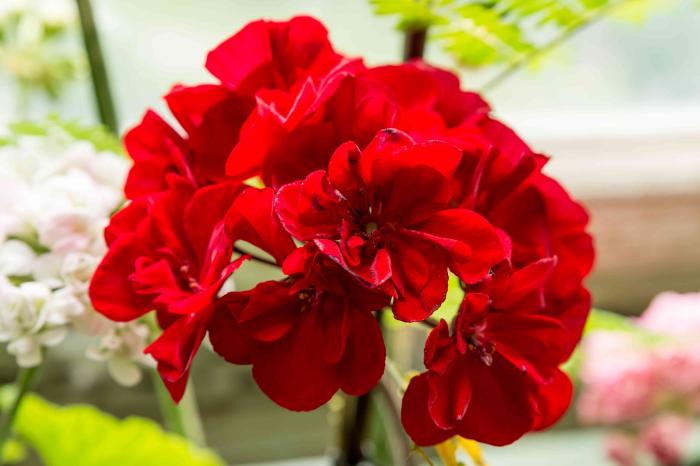Geranium flowers are popular in gardens and homes. They are not just beautiful; they also carry significant meanings. Understanding the symbolism behind geraniums can enhance your appreciation for these lovely blooms. This article explores the meaning of geranium flowers, their history, and their uses.
History of Geraniums
Geraniums belong to the Geraniaceae family. They originate from South Africa but are now grown worldwide. The plant has over 400 species. They are known for their vibrant colors and unique shapes. Geraniums have been cultivated for centuries. They were first introduced to Europe in the 17th century. Since then, they have become favorites among gardeners.
Symbolism of Geranium Flowers
Geraniums carry various meanings depending on their color and type. Here are some common interpretations:
Red Geraniums
Red geraniums symbolize true friendship and loyalty. They represent strong emotions and passion. These flowers are often given as gifts to express heartfelt sentiments. They can also convey admiration and respect.
Pink Geraniums
Pink geraniums represent a gentle, nurturing love. They are often associated with grace and happiness. People use pink geraniums to celebrate friendships and express appreciation. They are perfect for expressing feelings in a warm, friendly manner.
White Geraniums
White geraniums symbolize purity and innocence. They are often used in weddings and other ceremonies. Their soft color represents new beginnings and fresh starts. People often give white geraniums as gifts to wish someone well in their new journey.
Purple Geraniums
Purple geraniums carry a sense of mystery and enchantment. They symbolize creativity and imagination. They are often given as gifts to artists or anyone involved in creative pursuits. These flowers inspire originality and self-expression.
Blue Geraniums
Though less common, blue geraniums symbolize tranquility and peace. They evoke calmness and serenity. People often choose blue geraniums for soothing arrangements, especially in settings that promote relaxation.
Geraniums in Different Cultures
Geraniums have different meanings in various cultures. Understanding these cultural interpretations adds depth to their symbolism.
European Traditions
In Europe, geraniums are often associated with protection and security. They were believed to ward off evil spirits. People planted geraniums around their homes for good luck. In some cultures, geraniums were thought to bring good fortune.
Native American Symbolism
For some Native American tribes, geraniums symbolize healing. They were used in traditional medicine. The leaves and flowers were believed to have soothing properties. They were often included in herbal remedies to treat various ailments.
Asian Perspectives
In parts of Asia, geraniums are associated with resilience and strength. They symbolize the ability to overcome obstacles. These flowers are often used in celebrations and festivals to represent hope and perseverance.
Growing Geraniums
Growing geraniums is relatively easy, making them a favorite among gardeners. Here are some tips for cultivating healthy geraniums.
Choosing the Right Location
Geraniums thrive in bright, indirect sunlight. Choose a spot with at least six hours of sunlight daily. They can tolerate some shade but perform best in sunny areas. Make sure the location has good air circulation.
Soil Requirements
Geraniums prefer well-draining soil. A mix of potting soil and sand works well. Ensure the soil is rich in organic matter. Good drainage prevents root rot and promotes healthy growth.
Watering Tips
Water geraniums when the top inch of soil feels dry. Overwatering can lead to root rot, so be cautious. It’s better to underwater than overwater. Geraniums are drought-tolerant and prefer slightly dry conditions.
Fertilizing
Use a balanced fertilizer every four to six weeks during the growing season. This promotes healthy growth and vibrant blooms. Avoid fertilizing in the winter when plants are dormant.
Pruning and Deadheading
Regular pruning keeps geraniums healthy. Remove dead or yellowing leaves to promote airflow. Deadheading, or removing spent flowers, encourages new blooms. This helps maintain the plant’s appearance and vitality.
Uses of Geranium Flowers
Geraniums are not just ornamental; they have various uses.
Culinary Uses
Some geranium varieties are edible. The leaves and flowers can be used in salads and desserts. They add a unique flavor and aesthetic appeal to dishes. Geranium-infused syrups are also popular in beverages.
Aromatherapy
Geranium oil, extracted from the leaves, is widely used in aromatherapy. It has calming properties and can help reduce stress. Many people use geranium oil in diffusers, bath products, and massage oils.
Medicinal Uses
In traditional medicine, geraniums have been used for various purposes. They are believed to have anti-inflammatory and antiseptic properties. Some cultures use geraniums to treat minor wounds and skin irritations.
Decorative Uses
Geraniums are popular in floral arrangements and home decor. Their vibrant colors make them perfect for gardens, balconies, and indoor spaces. They can also be used in wreaths and centerpieces for special occasions.
See also: What Is The Meaning Of Sweet William Flower
Conclusion
Geranium flowers are more than just beautiful plants. They carry deep meanings and cultural significance. Understanding the symbolism of geraniums enhances their value in our lives. Whether used in gardens, culinary creations, or home decor, geraniums offer a range of benefits.
Their ease of care makes them accessible to all gardeners. By appreciating the meaning behind these flowers, you can choose the right ones for your needs. Whether you want to express friendship, celebrate love, or simply enjoy their beauty, geraniums are a wonderful choice.
Related topics:


